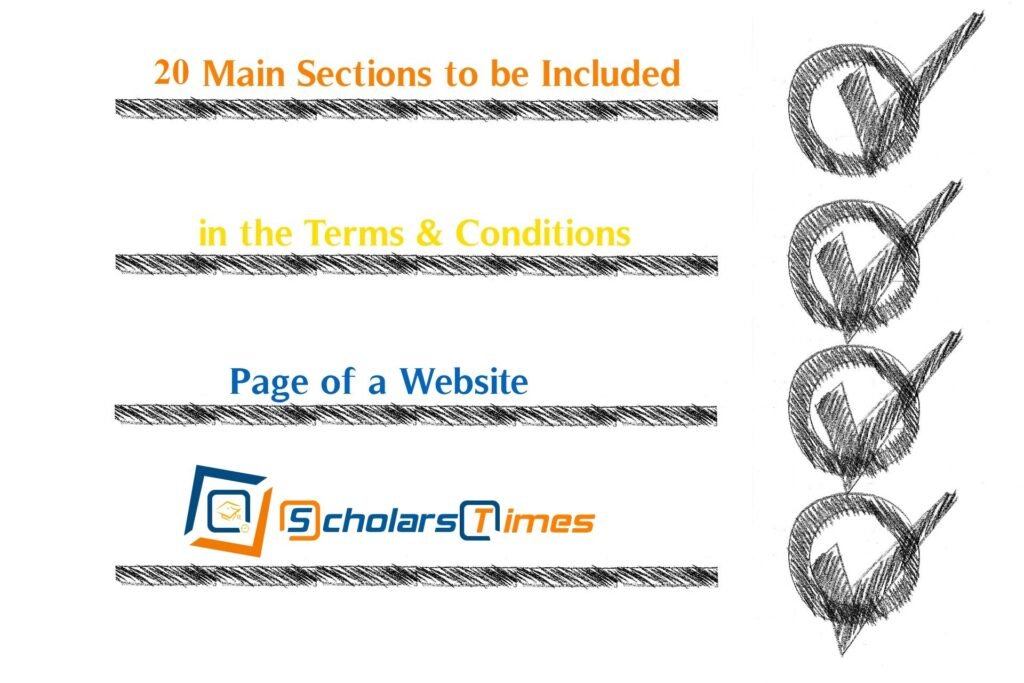20 Main Sections to be Included in the Terms & Conditions
5 min read
[ez-toc]
Main Sections of Terms Page of a Website
Definitions/Introduction:
- In this section, website is to be introduced first. Subsequently, all key words/terms/synonyms are defined. So that, reader/user may understand it in the context of specific given section listed below.
Content Usage Terms:
- This section outlines the terms and conditions under which users can access and use the content available on the website. This can include restrictions on the number of copies that can be made, the manner in which the content can be used, and the requirement for attribution.
Intellectual Property Rights:
- This section outlines the ownership of the content on the website and the rights of users with respect to the use of that content. This can include trademarks, copyrights, patents, and trade secrets.
Disclaimer of Warranties:
- This section outlines the warranties and representations that the website owner makes regarding the content on the website and any products or services offered through the website. This can include warranties of merchantability, fitness for a particular purpose, and non-infringement.
Indemnification:
- This section outlines the obligations of users to indemnify the website owner for any damages or losses incurred as a result of the user’s use of the website. This can include damages arising from copyright infringement, defamatory comments, or other violations of law.
User Content Submission Terms:
- This section outlines the terms and conditions under which users can submit content to the website, such as articles, comments, and photos. This can include restrictions on the type of content that can be submitted, the manner in which the content can be used, and the requirement for the user to grant the website owner a license to use the content.
User Conduct Restrictions:
- This section outlines the restrictions on user conduct while using the website. This can include restrictions on spamming, hacking, defamatory comments, and other forms of inappropriate behavior.
Changes to Terms and Conditions:
- This section outlines the procedure for making changes to the terms and conditions of the website. This can include the requirement for notice to be given to users and the requirement for users to agree to the changes.
Copyright Notice:
- This section outlines the procedure for reporting copyright infringement on the website and the procedure for the website owner to respond to such claims.
Digital Millennium Copyright Act (DMCA) Notice and Takedown Policy:
- This section outlines the procedure for reporting copyright infringement under the Digital Millennium Copyright Act and the procedure for the website owner to respond to such claims.
Advertising and Sponsorship:
- This section outlines the terms and conditions under which advertising and sponsorship is accepted on the website, including the requirement for disclosure of sponsored content and limitations on the manner in which advertising can be displayed.
Third-Party Links:
- This section outlines the terms and conditions under which the website owner may include links to third-party websites, including the requirement for disclosure of the relationship between the website owner and the third-party websites.
Feedback and Submissions:
- This section outlines the terms and conditions under which users can provide feedback or make submissions to the website, including the requirement for the user to grant the website owner a license to use the feedback or submissions.
Privacy Policy:
- A privacy policy should be included that outlines how the website collects, uses, and protects personal information from users. This is particularly important in jurisdictions such as the European Union, where privacy laws are strict.
Limitation of Liability:
- It is important to include a limitation of liability clause that limits the website’s liability for damages arising from the use of the site or the content available on it.
Dispute Resolution:
- A clause should be included outlining the process for resolving disputes, including any provisions for mandatory arbitration.
Governing Law:
- The governing law should be clearly stated, and it should specify the jurisdiction whose laws will govern the terms and conditions of the website.
Termination:
- A clause should be included specifying under what circumstances the website can terminate the terms and conditions or a user’s access to the site.
Children’s Privacy:
- If the website is intended for use by children, it is important to include provisions for children’s privacy and to comply with any applicable laws regarding children’s privacy.
Website Ownership and Contact Information:
- This section should elaborate on the proprietorship of the website whether It is owned by an Individual, Private Company or a Trust/NGO. Further, contact information should be provided here, so that user may contact the administrator in case of feedback, question or dispute.
Legal Requirements for a website’s Terms: USA, Europe, UK, Canada, and Australia
To ensure compliance, the following legal requirements should also be considered and addressed in the terms and conditions:
USA:
- COPPA (Children’s Online Privacy Protection Act) compliance for websites collecting information from minors under 13 years old
- ADA (Americans with Disabilities Act) compliance for website accessibility
Europe:
- GDPR (General Data Protection Regulation) compliance for data protection and privacy
- E-Commerce Directive compliance for online sales and consumer protection
UK:
- Data Protection Act compliance for data protection and privacy
- Electronic Commerce (EC Directive) Regulations compliance for online sales and consumer protection
Canada:
- PIPEDA (Personal Information Protection and Electronic Documents Act) compliance for data protection and privacy
Australia:
- Privacy Act 1988 compliance for data protection and privacy
- Australian Consumer Law compliance for consumer protection and fair trading.
It is recommended to seek the advice of a qualified lawyer to ensure that your terms and conditions comply with the legal requirements of your jurisdiction.







